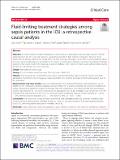| dc.contributor.author | Shahn, Zach | |
| dc.contributor.author | Shapiro, Nathan I. | |
| dc.contributor.author | Tyler, Patrick D. | |
| dc.contributor.author | Talmor, Daniel | |
| dc.contributor.author | Lehman, Li-Wei | |
| dc.date.accessioned | 2020-10-27T22:30:41Z | |
| dc.date.available | 2020-10-27T22:30:41Z | |
| dc.date.issued | 2020-02 | |
| dc.date.submitted | 2019-11 | |
| dc.identifier.issn | 1364-8535 | |
| dc.identifier.uri | https://hdl.handle.net/1721.1/128224 | |
| dc.description.abstract | Abstract
Objective
In septic patients, multiple retrospective studies show an association between large volumes of fluids administered in the first 24 h and mortality, suggesting a benefit to fluid restrictive strategies. However, these studies do not directly estimate the causal effects of fluid-restrictive strategies, nor do their analyses properly adjust for time-varying confounding by indication. In this study, we used causal inference techniques to estimate mortality outcomes that would result from imposing a range of arbitrary limits (“caps”) on fluid volume administration during the first 24 h of intensive care unit (ICU) care.
Design
Retrospective cohort study
Setting
ICUs at the Beth Israel Deaconess Medical Center, 2008–2012
Patients
One thousand six hundred thirty-nine septic patients (defined by Sepsis-3 criteria) 18 years and older, admitted to the ICU from the emergency department (ED), who received less than 4 L fluids administered prior to ICU admission
Measurements and main results
Data were obtained from the Medical Information Mart for Intensive Care III (MIMIC-III). We employed a dynamic Marginal Structural Model fit by inverse probability of treatment weighting to obtain confounding adjusted estimates of mortality rates that would have been observed had fluid resuscitation volume caps between 4 L–12 L been imposed on the population. The 30-day mortality in our cohort was 17%. We estimated that caps between 6 and 10 L on 24 h fluid volume would have reduced 30-day mortality by − 0.6 to − 1.0%, with the greatest reduction at 8 L (− 1.0% mortality, 95% CI [− 1.6%, − 0.3%]).
Conclusions
We found that 30-day mortality would have likely decreased relative to observed mortality under current practice if these patients had been subject to “caps” on the total volume of fluid administered between 6 and 10 L, with the greatest reduction in mortality rate at 8 L. | en_US |
| dc.publisher | Springer Science and Business Media LLC | en_US |
| dc.relation.isversionof | http://dx.doi.org/10.1186/s13054-020-2767-0 | en_US |
| dc.rights | Creative Commons Attribution | en_US |
| dc.rights.uri | https://creativecommons.org/licenses/by/4.0/ | en_US |
| dc.source | BioMed Central | en_US |
| dc.title | Fluid-limiting treatment strategies among sepsis patients in the ICU: a retrospective causal analysis | en_US |
| dc.type | Article | en_US |
| dc.identifier.citation | Shahn, Zach et al. "Fluid-limiting treatment strategies among sepsis patients in the ICU: a retrospective causal analysis." Critical Care 24, 1 (February 2020): 62 © 2020 Springer Nature | en_US |
| dc.contributor.department | Massachusetts Institute of Technology. Institute for Medical Engineering & Science | en_US |
| dc.relation.journal | Critical Care | en_US |
| dc.eprint.version | Final published version | en_US |
| dc.type.uri | http://purl.org/eprint/type/JournalArticle | en_US |
| eprint.status | http://purl.org/eprint/status/PeerReviewed | en_US |
| dc.date.updated | 2020-06-26T11:10:17Z | |
| dc.language.rfc3066 | en | |
| dc.rights.holder | The Author(s). | |
| dspace.date.submission | 2020-06-26T11:10:17Z | |
| mit.journal.volume | 24 | en_US |
| mit.journal.issue | 1 | en_US |
| mit.license | PUBLISHER_CC | |
| mit.metadata.status | Complete | |
